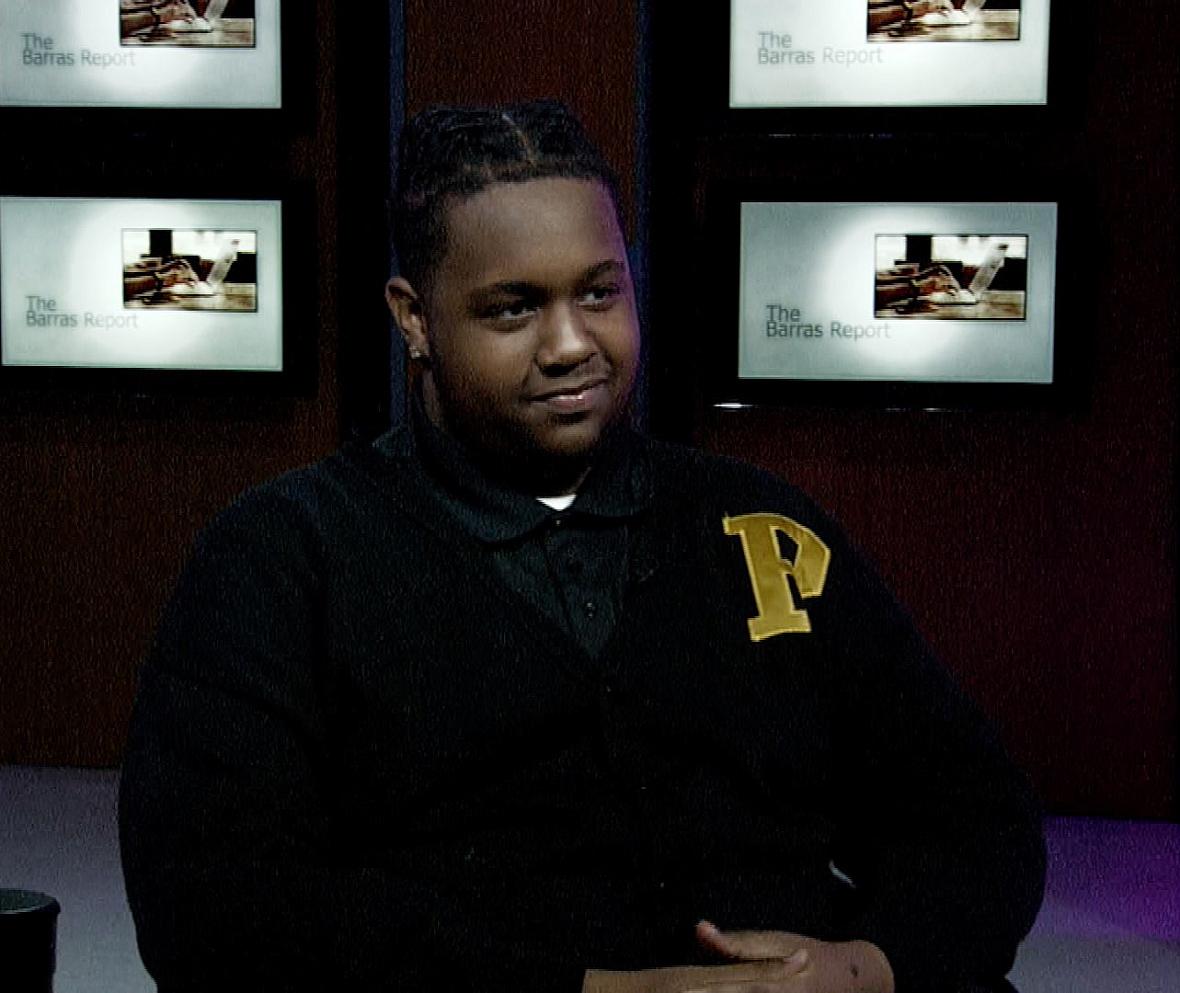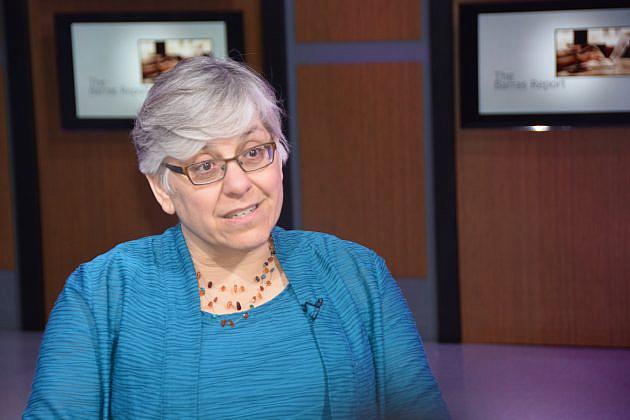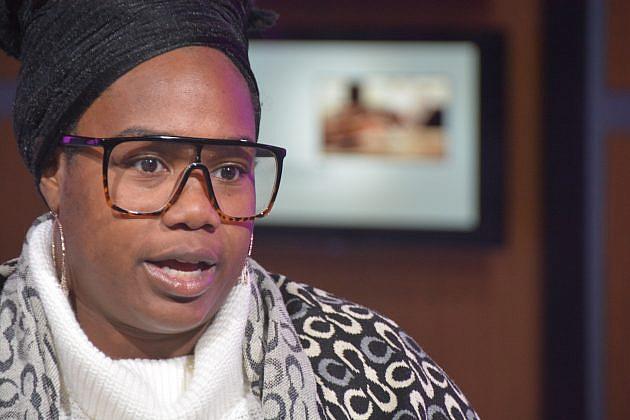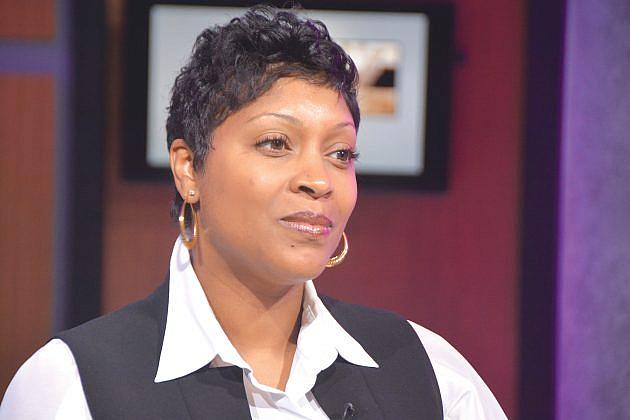The Cost of Juvenile Trauma
This series was produced as part of the University of Southern California Center for Health Journalism Fellowship with a grant from the Fund for Journalism on Child Well-Being.
Other stories in this series include:
A Traumatic Failure: DC Public Schools Neglect Mental Health
The Barras Report Special: Trauma, A Barrier to Academic Success

Davon Harris, a senior at Richard Wright Public Charter School for Journalism and Media Arts. Photo: UDC Television Interview
(Photo: Ed Jones, Jr./UDC-TV)
Twelve-year-old Talayia Richardson wore a lovely flowered sun dress that complimented her milk chocolate-colored skin; her long black hair was perfectly coifed; the sun seemed to burst across her smiling face as DC Attorney General Karl Racine (D) introduced her at a 2018 youth roundtable organized with Ward 6 DC Council member Charles Allen (D). Showcasing local winners of the “Do the Write Thing” essay contest, the event featured voices of students from traditional and charter schools, whose views frequently are drowned out by adults.
“Growing up in Washington, DC, I have seen more violence than any child should,” said Talayia, a student at the Wheatley Education Campus; her serenity belied the gravity of her history. As an infant sitting in a car seat, she was nearly killed by a random bullet that whizzed just past her head. She heard that story from her parents.
The loss of her “Uncle Brock to senseless violence” was her narrative to own. Locked in her memory, it surfaced in her essay. “His murderer was never found. No one answered lingering questions. Why did someone want Uncle Brock dead? Why did no one ever come forward who witnessed this horrific act of violence and tell who did it,” continued Talayia. “As a result, my family was scarred permanently.”
Davon Harris, a senior at Richard Wright Public Charter School for Journalism and Media Arts, suffered his own mental and emotional distress. As a young boy, he watched helplessly as his mother was abused. The domestic violence stopped only after she lost her job and the family was evicted from their home, scattering the members of the household, including his two siblings—each went to live with separate aunts.
Homeless for nearly three years, Davon and his mother moved from shelter to shelter or from shelter to transitional housing. “The transitional housing was so bad, there were times I wished we were in a shelter,” he told me. During those dark days he was depressed; “I expressed it as anger.”
A Mass of Pain
The minds and memories of thousands of young people in the District—and adults–are severely damaged by similar encounters with violence. Some experiences are up-close and personal; others are more distant. Collectively, they form an unhealed public wound that is felt in every ward of the city, without regard for race or class.
Consider that the 2016 National Survey of Children’s Health found that 47 percent of DC children and youth experienced two or more traumatic events as described by the Adverse Childhood Experience (ACE), which grew out of a 1998 study conducted by Kaiser Permanente and the Centers for Disease Control and Prevention. The local rate is far greater than the national average of less than 30 percent.

Researchers have concluded that children ages 6 to 17 who experience two or more ACEs are twice as likely to be disengaged from school compared to peers who have no ACEs.
“Trauma can be any extreme bad experience,” explained Judith Sandalow, director of the DC Children’s Law Center, which represents as many as 5,000 children to ensure they receive the services they need and deserve from government agencies, including public schools. “If [the problem] is in your family, it’s an ACE, but if it’s an outsider it’s still pretty horrible but it’s considered a trauma.”
“It probably doesn’t matter which one it is because they all create some of the same problems for kids,” added Sandalow.
Trauma inducing experiences can range from abuse and neglect, parental abandonment or incarceration, bullying, living in a home where there is chronic unemployment and palpable poverty, including not having enough food to eat or being unable to wash your clothing, living in a household where there is obvious substance abuse and its attending effects and witnessing domestic violence or general community violence.
“Trauma is ubiquitous” said Tanya Royster, MD, director of the DC Department of Behavioral Health. “Young people all across this city are traumatized. And some of it is primary trauma. Some of it is secondary trauma, but it’s trauma none the less.”
Despite that acknowledgment of the breadth and depth of trauma, the District has not offered a sustained and coordinated response to what legitimately can be described as an epidemic, according to advocates, parents, teachers, mental health specialists and even some government workers with whom I spoke. Most egregious is that there are inadequate numbers of mental health personnel in the city’s public schools, where many children and teens spend most of their time. Further, there are few available community treatment facilities.
Consider that an Oct. 30, 2017 report by DC Auditor Kathy Patterson of how eight elementary schools were spending funds allotted for social-emotional staffing indicated that at Moten in Ward 8 there was only one social worker and one psychologist for a population of 421 students. At Barnard in Ward 4, there was only one social worker and a half-time psychologist for a population of 642 students; that school also included an attendance counselor in the category of social-emotional staffers, according to the audit report.
At-large DC Council member David Grosso, chairman of the Committee on Education and Libraries, acknowledged that getting a handle on trauma is important to transforming the city’s public schools. “I firmly believe that we will not close the achievement gap until we effectively address the trauma that our students are facing.”
He said that after many years, “for the first time, [the city is] taking stock of school climates and their effect on our students’ mental health, as required by my Youth Suicide Prevention Act.”
Is It Enough?
Educators and other school-based staff have said no. “Interviewees who called for additional social-emotional resources emphasized that more attention to behavioral issues would reduce disruptions and impediments to learning, thereby benefiting all students,” Patterson wrote in her audit report.
“Trauma can affect children’s language development, inhibit their academic achievement and make it difficult to form relationships with both peers and adults,” explained Sandalow, who for the past five years has advocated for more trauma-informed or trauma-sensitive schools in DC. “Traumatized children may develop hyper-vigilance, emotional withdrawal or dissociation, and spend the school day focusing solely on their safety—making it impossible to learn.”
DC Attorney General Karl Racine said he and his team of lawyers have witnessed the fragile state of childhood in DC through the cases they represent like those associated with DC Child and Family Services Agency (CFSA) as well as child support requests. “In case after case [we] read psychological and psycho-social evaluations done for youth in the justice system and see signs of trauma.”
The Youth Risk Behavior Survey of 2017 conducted by The Office of the State Superintendent of Education (OSSE) queried 8,578 high school students and 8,799 middle schoolers. The results echo Racine’s assertion.
Many middle schoolers–16.2 percent of African-Americans, 18.5 percent of Hispanics, 6.1 percent of whites and 11.5 percent of Asians– reported missing school one or more days because they said they felt unsafe. An increasing number, according to the survey, had been involved in fights, undoubtedly part of their attempt to protect themselves in what they perceived as a hostile environment. Meanwhile, 26.7 percent of the survey’s middle school respondents said they carried a weapon, an increase from 23.1 percent two years previously.
Nationally, noted Racine, as much as 90 percent of youth in the juvenile justice system report experiencing a traumatic event. On average, 70 percent of them have mental health disorders, and approximately 30 percent suffer from Post-Traumatic Stress Disorder. Of youth aged 10 to 18 in a juvenile detention center, 92.5 percent have experienced at least one traumatic event, with a median average of six traumatic occurrences.
Scientists have found that the brain structure of children who experience chronic trauma often is permanently altered. Moreover, the constant state of alertness triggered by trauma instigates the release of stress hormones that can result in a child or youth being in the constant state of “fight, flight or freeze.” In such a condition, said Racine, “it is hard for the other parts of the brain to work.”
Beyond Guns
District officials, advocates, civic leaders and the media have focused a disproportionate amount of attention on trauma triggered by gun violence. Unquestionably that is concerning, and solutions should be sought. However, injuries from other traumas, including those attached to chronic poverty, have been equally damaging, affecting children and youth in the District in ways that go ignored.
Finesse Graves is illustrative of that fact. She may have never met Talayia or Davon. However, their stories intersect at the crossroad of trauma and pain: “I was raped when I was going to get drugs for [my mother] when I was a child,” Finesse told me recently as we sat inside the parent conference room at her daughter’s school. “These are things that I don’t tell people about. I don’t want to talk about them.”
Finesse Graves. (Photo: Ed Jones, Jr./UDC-TV)
At one point in her youth, Finesse knocked on the door of the foster care agency in Maryland, pleading to be admitted. “When I was younger, I used to go to the library; they used to always have posters up about people adopting kids. They make it look like it’s a happy story. All you have to do is sign up and you get adopted.
She told the folks at the agency her grandmother was very sick; her mother was a heroin addict who was in and out of her life. The foster care worker said Finesse “needed to be experiencing some type of trauma. I explained to her I was living in trauma.
“When my grandmother died, I went backwards,” continued Finesse. “Things started flashing in my head: ‘Why am I going through this? What am I here for? If I’m just going to keep having to go through tragedy after tragedy after tragedy, what is the purpose?’ ”
Satira Streeter, a psychologist who founded Ascensions Psychological and Community Services in Ward 8, explained that trauma can be passed from generation to generation. “[It] is being passed down in terms of the coping strategies and lack thereof. At the same time, you’re getting your mama’s trauma, but then you’re getting traumatized yourself. So, it’s just like all these compound traumas that continue to build, build, and build. It’s extremely significant.”
After being traumatized repeatedly as a child, Finesse, as a young adult, found herself homeless and pregnant. She could not find a shelter. “I slept on a bench at Union Station,” she recalled. Her daughter thus began experiencing trauma in the womb.
Eventually, a manager at a local nonprofit referred her to a shelter for women. Finesse’s pregnancy became complicated. She was ordered to stay in bed, which was impossible to do while living at the shelter. She soon found herself on the streets, again. Unsurprisingly, her daughter was born premature.
“I’ve never hidden anything from my daughter, so she’s seen the struggle. When she was two and three years-old and I was on the floor crying, she was consoling me. She was the person that was there for me. If it wasn’t for her, I probably wouldn’t have been able to get through nothing that I got through at a certain point in time. I felt like that it affected her,” said Finesse.
“I think that the time when I can say that she started going through traumatic issues was probably when we left the [homeless] shelter,” added Finesse.
Finesse and her daughter, now in the second grade, moved in with Finesse’s mother, who lives in Ward 8. The apartment is so riddled with housing code violations, Racine’s office has filed a lawsuit against the owner, demanding conditions be improved.
And so, the cycle of trauma has continued.
A Hidden Story Waiting To Be Told
“Every student that walks into a school has a story behind them,” said Davon, adding that when he was experiencing homelessness, “Instead of expressing my emotions I kept it to myself. I walked around not saying anything. I was quiet. I wasn’t mad at anyone in particular, I was mad at the situation I was in.”
Consistent with what experts have said about the impact of trauma on learning, Davon failed the seventh grade. “I had an “A” in math but an “F” in every other subject,” he confessed, adding that during those days he didn’t really talk to anyone. The thing on his mind was basic survival.
“When we were in the shelter, people kept leaving and coming back and leaving. And me and my mother kept asking ourselves when it is our turn to leave. When are we going to find our apartment,” recalled Davon. “In school that was all I could think about: When was our time coming? What is going to happen to us?”
In traditional, by-right public schools east of the Anacostia River where there are documented high levels of violence and unresolved trauma, students consistently score below proficient on standardized tests. Schools west of the river are also affected, since many parents place their children in institutions outside their neighborhoods.
In the eighth grade Davon managed to get accepted to Richard Wright, a Ward 6 school. An automobile accident that left him fearing his mother’s death and the possibility that he would be left without anyone to care for him, inspired him to search for a bright light in his world. He also chose to seek the services of a therapist. Davon is one of the lucky ones.
Many students in the city’s public schools don’t have the benefit of seeing a psychiatrist, psychologist or therapists on a regular basis as evident by the auditor’s Oct. 2017 report. Documents provided to me by the DC Office of the Deputy Mayor for Education (DME) indicate there are only 22 full or part-time psychiatrists in a school system with a population of 92,994 students. They are supplemented by 221 full-time or part-time psychologists.
Most mental health counseling in the public schools is provided by 261 full or part-time social workers and 104 licensed counselors, who may or may not be trained in how to deal with children suffering trauma.
What are they doing, and are they having any impact? Can they change the trajectory of education reform in the District?
Davon told me there are times he has had to wait a week for his in-school therapist to respond to a crisis he may be experiencing. “By then, I have worked it out by myself,” he added.
“The everyday traumas children might experience in their homes, schools and within our society can impact and shape their minds and keep them from being the best version of themselves,” said Rose Shelton, a therapist and a Ward 6 parent leader of the group Parents Amplifying Voices in Education (PAVE).
Rose Shelton, a therapist and a Ward 6 parent leader of the group Parents Amplifying Voices in Education (PAVE). (Photo: UDC Television Interview, photographer, Ed Jones, Jr/UDC-TV)
The Overstuffed Backpage
Most experts and advocates were not surprised by the OSSE report. DC students are in the middle of a traumatic crisis. They keep shouting. Apparently no one is really listening.
Sandalow used a backpack as analogy to describe the situation. Her granddaughter had to take one to summer camp. “By the time I put her lunch and her snacks and her change of clothes and her swimsuit and her towel, this little 4-year-old body is carrying this really heavy backpack and she gets tired. She’s like, ‘”Grandma, will you carry it for me?
“So, I think our kids are carrying this backpack with the physical abuse,” Sandalow continued. “With the shooting, with the fear of homelessness, it’s almost like a trauma backpack, right? They are walking into school with this incredibly heavy weight. It makes it harder for them to learn.”
[This story was originally published by HillRag. It also ran in East of the River News and Mid City DC News.]

